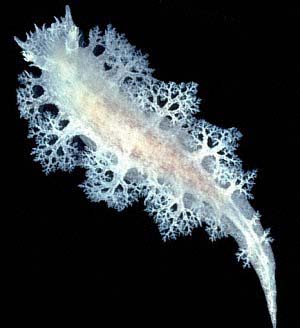
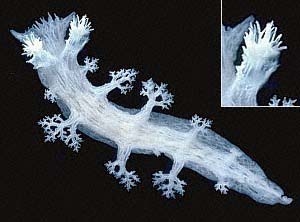
Tritoniopsis elegans
(Audouin, 1826)
Order: NUDIBRANCHIA
Suborder: DENDRONOTINA
Family: Tritoniidae
DISTRIBUTION
Indo-West Pacific.
PHOTO
UPPER: Adult animal aproximately 50mm long, Coffs Harbour region, New South Wales, Australia, October 1990.
LOWER: Juvenile animal, approx 20mm long, Solitary Is, Coffs Harbour Region, New South Wales, October 1990. Inset showing characteristic tritoniid rhinophoral tentacles). PHOTOS: Bill Rudman.
This is a widespread Indo-West Pacific species reported from the Red Sea, Japan and eastern Australia. I have further records from New Caledonia and Tanzania. All specimens have a pattern of opaque white patches, what differs is that in some specimens the background color is translucent clear (as illustrated here), while in others it is a translucent or opaque orange or orange-red. This colour difference does not appear to be food-related for both colour forms can be found together on the same colony of the soft-coral, Lobophyton, on which they feed. The white colour form was described from Japan as Tritoniopsilla alba Baba, 1949 but both colour forms can be found together throughout the species range.
Reference:
• Audouin, V. (1826). Explication sommaire des planches de Mollusques de l'Egypte et de Syrie publiees par J.C. Savigny. Description de l'Egypte ou recueil des observations et des recherches qui ont été faites en Egypte pendant l'expedition de l'armée françaises, publie par les ordres de sa majeste l'empereur Napoleon le grand. Histoire Naturelle, Animaux invertebres, 1(4): 7-56. Imprimiere imperiale: Paris.
Rudman, W.B., 1999 (January 4) Tritoniopsis elegans (Audouin, 1826). [In] Sea Slug Forum. Australian Museum, Sydney. Available from http://www.seaslugforum.net/find/triteleg
Related messages
Tritoniopsilla elegans - egg laying
September 19, 2008
From: Sven Kahlbrock
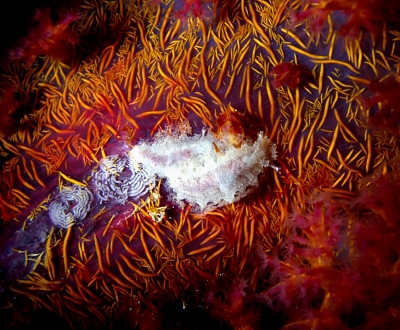
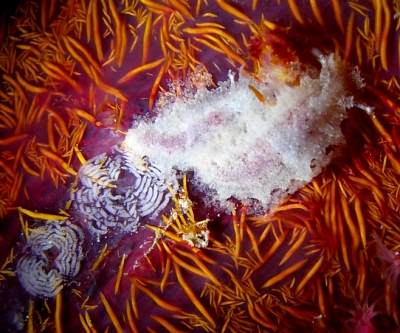
Hello Bill,
Here is a new species for me which I found during a night dive in El Fanadir / Hurghada, in the Egyptian Red Sea. There were a couple in a soft coral. Is it possible, that they are Tritonia alba?
Locality: El Fanadir Foc / Hurghada, 14 m, Egypt, Red Sea, 25 march 2008, at soft corral. Length: 12 mm. Photographer: Sven Kahlbrock.
Sven Kahlbrock
s_kahlbrock@web.de
Kahlbrock, S., 2008 (Sep 19) Tritoniopsilla elegans - egg laying. [Message in] Sea Slug Forum. Australian Museum, Sydney. Available from http://www.seaslugforum.net/find/21564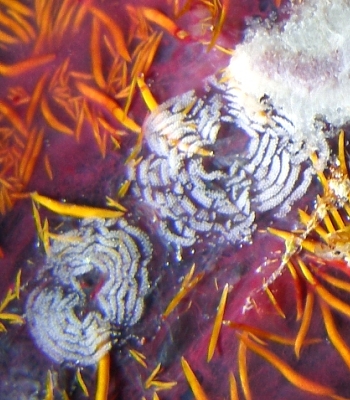
Dear Sven,
Thanks for these interesting photos. It is Tritoniopsis elegans. For some years the white form was known as Tritoniopsilla alba, which I guess is where you got the name Tritonia alba. The white spirals in your photos are egg ribbons, almost certainly of this species.
The soft coral in your photos looks very like a species of Dendronephthya, which makes me wonder just what this species usually feeds on. It has been thought that it feeds on the leathery soft coral Lobophyton [Family Alcyoniidae] but we have a number of records on the Forum of it feeding on Dendronephthya . Perhaps earlier records of it on Lobophyton are wrong? Looking at Bernard Picton's message from Hong Kong [#5075 ], the soft coral I tentatively identified there as Lobophyton could well be the neptheid Capnella. This could suggest that Tritoniopsis elegans specialises on soft corals of the Family Neptheidae but clearly a lot more work needs to me done - another thing to add to our 'to do' list.
Best wishes,
Bill Rudman
A case of Caphira yoodokai eating Tritoniopsis elegans
July 7, 2007
From: Seiko Kuroe & Akira Mada
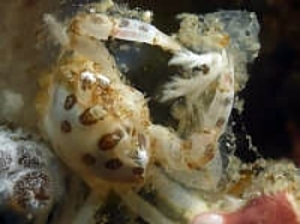
Dear Bill,
We observed an interesting case of the crab Caphra yookadai eating Tritoniopsis elegans. While watching Tritoniopsis elegans eating the soft-coral Lobophyton, a Caphra yookadai which lives in the soft-coral, came completely out of the Lobophyton (which is quite rare), and started to pinch off parts of the Tritoniopsis elegans, and to eat them. The Tritoniopsis elegans started to move away from the Lobophyton at a quite a fast pace.
Locality: Futoh beach, west Izu Peninsula, 4 metres, Shizuoka, Japan, Pacific ocean, 30 May 2007, A lone rock (in a sandy area. Length: 3 cm. Photographer: Akira Mada.
We do not know whether the crab attacked the Tritoniopsis elegans in an attempt to protect the Lobophyton, which is its habitat, or just as food. But it was an interesting event and we wish to continue the observation.
Yours sincerely,
Seiko Kuroe & Akira Mada
umi110kuroe@docomo.ne.jp
Seiko Kuroe & Akira Mada, 2007 (Jul 7) A case of Caphira yoodokai eating Tritoniopsis elegans. [Message in] Sea Slug Forum. Australian Museum, Sydney. Available from http://www.seaslugforum.net/find/20129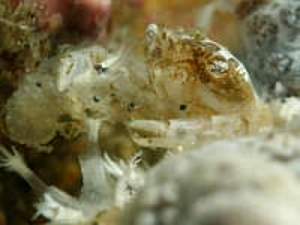
Dear Seiko & Akira,
This is a interesting observation - if sad for the nudibranch. It is a good addition to the predators page. As you suggest, it would be interesting to know if the crab was protecting its 'territory' or just eating some food. These soft-corals have some very distasteful chemicals in their tissues some of which can accumulate in the nudibranch's skin. From your description it seems the crab is not put off by them.
Best wishes,
Bill Rudman
Tritoniopsis elegans in aquarium
March 13, 2007
From: Andrea Urban
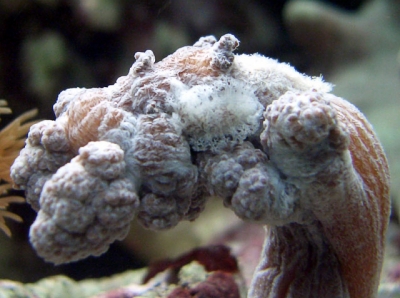
Dear Dr. Rudman,
Just like to say what a great forum!!! I found this interesting guy feeding on this species of softcoral in my aquarium. I´m really interested to know the ID. Thanks a lot!
Best wishes,
Andrea Urban
a-urban@gmx.de
Urban, A., 2007 (Mar 13) Tritoniopsis elegans in aquarium. [Message in] Sea Slug Forum. Australian Museum, Sydney. Available from http://www.seaslugforum.net/find/19618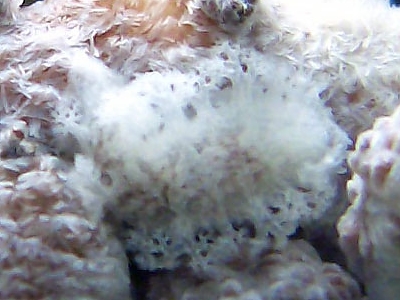
Dear Andrea,
This is Tritoniopsis elegans, from the tropical Indo-West Pacific. It looks very spectacular when photographed on a black background, looking like a piece if lace-work but on its natural background it is hard to see. If you have a look at the Fact Sheet, and other messages, you will see that this species has become quite a common find in home aquaria. It obviously hitches a ride on the leathery soft corals on which it feeds.
Best wishes,
Bill Rudman
Feeding Tritoniopsis elegans
August 17, 2006
From: Vik Shah
Hello,
I found Tritoniopsis elegans [about 2 cm long] in my tank just the other night, and looking though some books and the intenet (love google) I found its name and this forum...
I'd like to know what corals does this eat specifically, I'd like for it to grow and for that I need to feed it. It was a stow-away on some live rock I purchased two days ago.
Can someone in Sydney tell me what corals does it eat and where can I buy them... I dont want it to die, its too damn beautiful...
TIA
Vik Shah
Sydney, NSW
vik@dlagroup.com.au
Sha, V., 2006 (Aug 17) Feeding Tritoniopsis elegans. [Message in] Sea Slug Forum. Australian Museum, Sydney. Available from http://www.seaslugforum.net/find/17490Dear Vik,
I'm glad you don't want to kill it - most aquarium keepers that have wriiten to the Forum have been more concerned about their soft corals than the nudibranch. On the species Fact Sheet I mention it feeds on the soft coral Lobophyton and there was probably a small colony of it on your 'live rock'. If you look through the messages about Tritoniopsis elegans on the Forum you will find a few photos of the soft coral which may help you find it in an aquarium shop. I'm afraid I don't know what common names are used for the soft coral. It's possible it will eat other leathery soft corals as well as Lobophyton, but I am not sure which ones
Best wishes,
Bill Rudman
Can you help Identify this hitchhiker?
January 13, 2006
From: Jimmy Carmichael
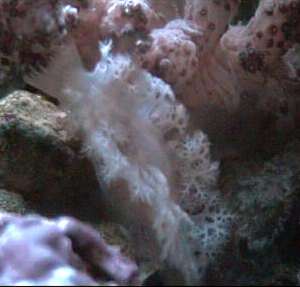
This Nudibranch has arrived in my Marine aquarium during the last month, I believe he has stowed away on a piece of liverock I recently purchaced. He seems to be quite active in the evenings sometimes on the glass but recently has taken a liking to a piece of Pussy Coral which I am worried he is eating!
Any information on his diet, species etc would be most appresiated.
Jimmy Carmichael
no1carmichael@icqmail.com
Carmichael, J.J., 2006 (Jan 13) Can you help Identify this hitchhiker?. [Message in] Sea Slug Forum. Australian Museum, Sydney. Available from http://www.seaslugforum.net/find/15541Dear Jimmy,
I have been planning a guide to the 6 most common aquarium hitchhikers and this animal would be near the top of the list. It is Tritoniopsis elegans, a soft-coral feeding nudibranch which is widespread in the tropical Indian and west Pacific Oceans. I am not good on common names so I am not sure what a 'pussy- coral' is, but from your photo it is definitely a soft coral, and from your account is the most probable food of the nudibranch.
I guess you have to make a value judgement on whether you want to keep the beautiful nudibranch, which will mean regularly buying new soft coral, or whether you want to stick with your dull bit of 'pussy-coral'. I guess I am a bit biased.
Best wishes,
Bill Rudman
Unidentified Nudibranch in aquarium
December 24, 2004
From: David Seibel
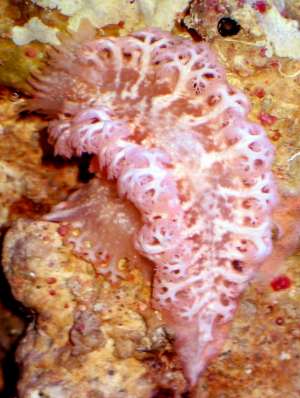
Dear Bill
I’m hoping someone with more nudibranch identification experience might have an idea about the two pink-white slugs that appeared in my tank recently. I’m afraid my pictures are coming out slightly blurry. I haven’t added anything but fish to the tank in about 6 months. Suddenly, one of the soft corals started to look increasingly ill. Then the slugs pictured appeared crawling all over it. They have stayed on the coral for 3 days and I can only assume they are eating it. Odd curly white strands have also appeared in bunches in the immediate area. The slugs are less than 2 inches in length and the strands can be as long as 5 inches— I have seen the strands appearing to come from the slugs themselves like waste product (or reproductive structures?).
Any guidance would be greatly appreciated!
Thanks.
David
dseibel@insightpartnersonline.com
Seibel, D., 2004 (Dec 24) Unidentified Nudibranch in aquarium. [Message in] Sea Slug Forum. Australian Museum, Sydney. Available from http://www.seaslugforum.net/find/12700Dear David
This is Tritoniopsis elegans. As you will see by the other messages on this page this species is a common aquarium 'hitchhiker'. The white strands you mention are its egg ribbon.
Best wishes
Bill Rudman.
Tritoniopsis elegans from Red Sea
August 11, 2004
From: Oren Lederman

Hi Bill,
I know you have been busy in the last few months, but never the less, you might find this interesting. I hope you'll have the time to read this.
A few months ago I found a orange-red nudibranch. At first I wasn't even sure it was a nudibranch, but after zooming in with my camera i was sure. It looks like a type of a Tritoniopsis, similar to the Tritoniopsis frydis on your site (thanks for Matan Ninio for finding it on your site). Since then, I re-visited this nudibranch and it seams like it stays on the same spot (the same soft coral) all the time. Last time I saw it I actually found 3 nudibranchs of this kind. I hope you can identify it.
Location - Red Sea, Eilat. Night dive. Depth - 5.5 Meters. Size - about 4cm long. One of them was smaller.
On this photo you can see two of the nudibranchs.
Take care,
Oren Lederman
lederman@bigmail.co.il
Lederman, O., 2004 (Aug 11) Tritoniopsis elegans from Red Sea. [Message in] Sea Slug Forum. Australian Museum, Sydney. Available from http://www.seaslugforum.net/find/12743
Thanks Oren,
I always read messages - and I am always interested - what is frustating is the lack of time to answer them. Your animal is indeed a species of Tritoniopsis. It is Tritoniopsis elegans which ranges in colour from orange to white. It was originally described from the Egyptian Red Sea about 180 years ago. It seems to feed on the soft coral Lobophyton and is often found nestled on the trunk of a colony or around the edge of more flattened colonies. If you regularly dive the same area it might be interesting to make regular observations on the colony and the slugs. We know nothing about their life history so don't know if they live for only a year, whether they kill the soft coral colony etc etc.
So any observations would be of value
Best wishes,
Bill Rudman
Tritonopsis elegans from Kenya
July 19, 2004
From: Ann Clear
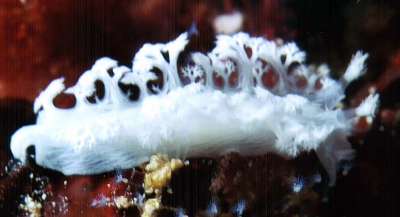
Hi Bill,
Having just returned from a diving holiday in the marine park in Watumu Kenya. My husband spotted this little devil and we think it is a Tritonopsis elegans, but a long way from home!!!
I would like to know if you agree.
Many thanks,
Ann Clear
lesandann@scubadiving.fsworld.co.uk
Clear, A., 2004 (Jul 19) Tritonopsis elegans from Kenya. [Message in] Sea Slug Forum. Australian Museum, Sydney. Available from http://www.seaslugforum.net/find/12604Dear Ann,
Yes this is T. elegans. Although most finds have been in the Pacific, it does occur in the Indian Ocean. It was first described from the Red Sea and I found it in Tanzania in the 1970s so it's not a recent arrival.
Best wishes
Bill Rudman
Re: Tritoniopsis elegans in aquaria [2]
March 16, 2004
From: Albert Jeffer
That's the monster, thank you for the ID [#12439]. There's still an egg mass if anyone knows what I should do with it, and if they hatch I'd be glad to send babies out. Otherwise they will just be executed via porcelain chair.
Albert Jeffer
acidbaby@bellsouth.net
Jeffer, A., 2004 (Mar 16) Re: Tritoniopsis elegans in aquaria [2]. [Message in] Sea Slug Forum. Australian Museum, Sydney. Available from http://www.seaslugforum.net/find/12443Tritoniopsis elegans in aquaria
March 12, 2004
From: Wade Waldman
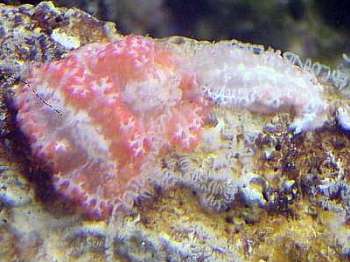
Can you identify this and is it going to cause problems in my aquarium. they are multiplying in my tank
Wade Waldman
wcwaldmn@aol.com
Waldman, W., 2004 (Mar 12) Tritoniopsis elegans in aquaria. [Message in] Sea Slug Forum. Australian Museum, Sydney. Available from http://www.seaslugforum.net/find/12436Dear Wade,
This is Tritoniopsis elegans. See the species Fact Sheet and attached messages for information. Basically the slugs have reached maturity, and are laying eggs [the tangled strings in your photo]. I am not sure that the larvae will survive in aquarium conditions to start a new generation, but the adults will survive until they have eaten the soft coral colony, in your aquarium, which they apparently arrived on as juveniles
Best wishes
Bill Rudman
Tritoniopsis elegans in aquaria [2]
March 12, 2004
From: Albert Jeffers
I have a white Nudi feeding on a bushy leather coral I have. The coral is unidentified, and looks like a cross between Cladiella and Kenya Tree. The nudi is white, with branching apparatus that resembles the coral with polyps closed. I wish I had a picture but the nudis were doing too much damage and I removed them. They laid a spiral translucent egg mass, so I am sure thewre are more coming.
Can anyone help me ID and rid myself of these guys? I would be glad to supply specimens to anyone interested.
Thank you,
Albert Jeffers
acidbaby@bellsouth.net
Jeffers, A., 2004 (Mar 12) Tritoniopsis elegans in aquaria [2]. [Message in] Sea Slug Forum. Australian Museum, Sydney. Available from http://www.seaslugforum.net/find/12439Dear Albert,
I guess your animal is Tritoniopsis elegans. See the species Fact Sheet and attached messages for information and photos.
Bill Rudman
Finally found in Queensland
November 19, 2003
From: Gary Cobb
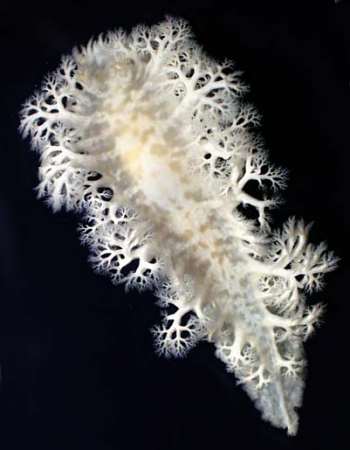
Hi Bill,
After searching for over a year and a half I finally found Tritoniopsis elegans.(if my ID is correct) There were 4 of them huddled together on a section of reef called Fairyland Boulders on the Sunshine Coast, Southern Queensland, Australia. Depth 17m, Water temp 22 degrees, length 50mm.
I think this is probably the most beautiful nudibranch in the sea. The tiny branches that come off the body must be good for something ... do you know? Is there a purpose for them? I noticed the it folds the branches up together when frightened.
Thanks,
Gary Cobb
gary@cobb.com.au
Cobb, G., 2003 (Nov 19) Finally found in Queensland. [Message in] Sea Slug Forum. Australian Museum, Sydney. Available from http://www.seaslugforum.net/find/11439Dear Gary,
Congratulations on your find. Yes it is Tritoniopsis elegans. It is certainly difficult to find, often living at the edge of the soft coral colony it is feeding on, nestled into crevices during the day. As our aquarium-keeping friends have also discovered, one of the best ways to find this species is to keep the leathery soft corals it feeds on in your aquarium. Many soft coral colonies harbour small, almost invisible, juveniles which flourish and grow in the less dangerous waters of an aquarium, where fish are well fed.
The branched proceesses on the side of the body are gills. I suspect they are also useful in making the edge of the animal quite irregular which is a useful technique in camouflage. The curling up of these branches when 'frightened' seems to be a fairly basic defensive response animals have to protect small delicate parts of their body from damage
Best wishes
Bill Rudman
Re: Tritoniopis elegans in aquarium
July 18, 2003
From: Chris Peacock
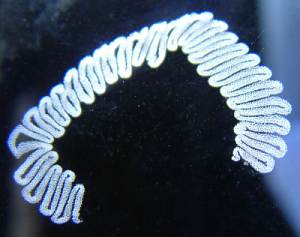
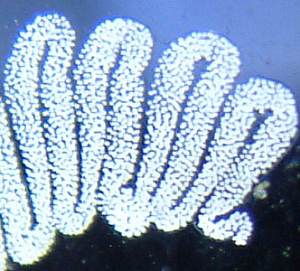
Thank you for your reply, Bill. Unfortunately, the Tritoniopsis died a few days after my last message - it ceased appearing after lights out, and I found a white ball of slime on the substrate a couple of days later. Now here's the intriguing part: having disposed of the remains, I went away for a week, and returned to find lots of algae on the tank glass plus this zig zag white thread on the glass. If you look closely, there are no algae around the thread - almost as if it has a natural algae-repellent. Blown up, the thread looks like an egg string. How is this possible, from just one short-lived nudibranch? No others are visible, and there is no obvious damage to the three small soft corals in my small (2ft) tank - a small Scleronephthya, a colony of Briareum, and a colony of Pachyclavularia. All undamaged! And after two days back, no sign of movement if it is a creature, no sign of hatching if it is an egg string. Any ideas/advice?
Chris Peacock
chris@anewperspective.co.uk
Peacock, C., 2003 (Jul 18) Re: Tritoniopis elegans in aquarium. [Message in] Sea Slug Forum. Australian Museum, Sydney. Available from http://www.seaslugforum.net/find/10458Dear Chris,
The mystery object certainly looks like a tritoniid egg ribbon. Have alook at earlier messages on this species and you'll see photos of the egg ribbons. So it looks like you may have a second animal in your tank.
Best wishes,
Bill Rudman
Tritoniopis elegans in aquarium
July 5, 2003
From: Chris Peacock
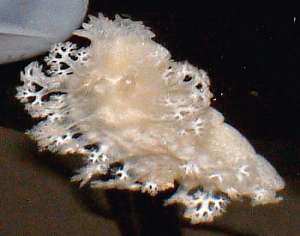
This sea slug suddenly appeared in my new marine aquarium (one month old). The photos are not great, because it only comes out at night, and makes a beeline for the water surface. It instantly disappears if I switch on the tank lights, so trying to focus through rippling water in dim light is extremely difficult.
Could you tell me please,
a) what species it is,
b) what are my chances of keeping it alive, c) what does it eat?
Many thanks,
Chris Peacock
London, England
chris@anewperspective.co.uk
Peacock, C., 2003 (Jul 5) Tritoniopis elegans in aquarium. [Message in] Sea Slug Forum. Australian Museum, Sydney. Available from http://www.seaslugforum.net/find/10362Dear Chris,
Your animal is Tritoniopis elegans which commonly 'appears' in aquaria. If you look at the Fact Sheet and other messages on this page you will see that it feeds on soft corals and 'hitches' a ride when very small on soft coral colonies. If you don't mind having your soft corals slightly chewed, then your slug has a good chance of surviving in your aquarium.
Best wishes,
Bill Rudman
Tritoniopsis elegans in aquarium
May 30, 2003
From: Ember Barnett
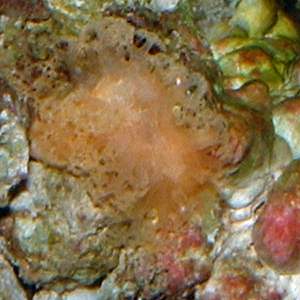
I found this in my tank is it a sea slug?
Ember Barnett
ebarnett@charter.net
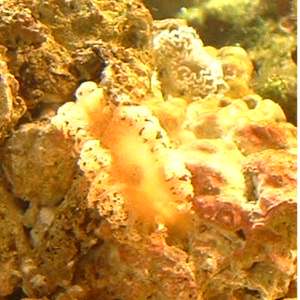
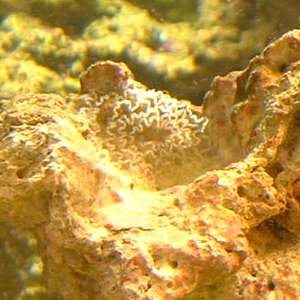
Dear Ember,
This is indeed a sea slug. It is Tritoniopsis elegans which feeds on certain soft corals. It probably got into your aquarium on such a soft coral. In the lower two photos I have enlarged sections of your photos to show its white spiral egg strings. Scroll up and down the page to look at the other messages about this species.
Best wishes,
Bill Rudman
Tritoniopsis elegans in home aquarium
February 28, 2003
From: Brian Lindsay
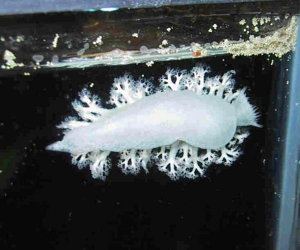
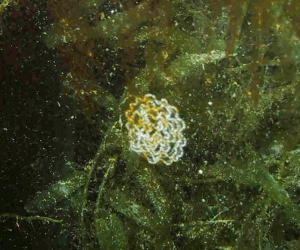
Dear sir
I found a jelly type growth beneath a rock in my marine aquarium. It was approx 3inches by 1/2 inch, white and pinkish colour. I tried to remove it and it came away in five separate pieces.
I put all 5 pieces into my refugium to quarantine them. Next day all 5 were spread around. All were white with little tree-like growths on the top side. Today they were grouped together and left this circle of eggs. Would appreciate it if you could identify this possible nudibranch.
Thanks
Brian Lindsay
Canada
brilin@sympatico.ca
Lindsay, B. , 2003 (Feb 28) Tritoniopsis elegans in home aquarium. [Message in] Sea Slug Forum. Australian Museum, Sydney. Available from http://www.seaslugforum.net/find/9300Dear Brian,
This is a tritoniid nudibranch called Tritoniopsis elegans. If you look at the other messages on this page you will see that it is quite a common hitch-hiker in aquariums. It almost certainly arrives as a small almost invisible juvenile on softcoral colonies.
Best wishes,
Bill Rudman
ID Sea Slug
February 13, 2003
From: Joe
It is 1 inch long, plain white....(kind of boring...) Small antenae..Back is plain with a few branching tentacles..or whatever they may be called....Any idea?
Joe
Scanza1701@hotmail.com
Dear Joe,
I guess this is an aquarium find. I am not a miracle worker. It's like asking me to identify a fish you've found by saying 'its got fins'! I need more information and preferably a photo. The only possibility I can think of from your description is Tritoniopsis elegans - but that is no more than a guess. If it does fit the photos on that page, you will find more about it by looking at some of the earlier messages
Best wishes,
Bill Rudman
Re: Tritoniopsis elegans in aquarium
January 25, 2003
From: Marc Daniels
Bill-
Thank you for all the information. I've since contacted Mary Middlebrook, who had also asked about the same nudibranch, and it looks like I'll be taking these pests off her hands. They're a problem to a coral farm/wholesaler, but for someone doing larval research they're are an ideal subject.
Thanks again,
Marc Daniels
Marc_Daniels@billing.com
Dear Marc,
Sounds like a happy ending for both you and Mary. I didn't know you were doing larval research. From the various reports on the Forum it looks like the larvae may be lecithotrophic [ie - non-feeding & spending only a short time as swimming veligers]. It would certainly be interesting to know for sure. Any results you wish to share with the Forum would be very welcome
Best wishes,
Bil Rudman
Are these Tritoniopsis elegans eggs?
January 25, 2003
From: Onel
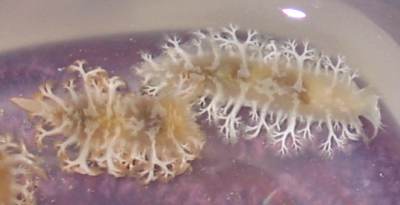
I posted a question on 'About Saltwater Aquariums' and this site was recommended as possibly being able to help. Following is the original post:
"I purchased a Sinularia or Cladiella coral about two weeks ago. It's looked fine for the first few days but then started closing up. I changed it's position in the tank a few times but noticed yesterday that it was getting smaller and portions appeared to be deteriorating. Well, upon closer inspection I saw something eating away at the coral which looks like some sort of slug (I've seen them once before eating my Colt coral). I pulled out the rock to remove the slug and found a total of SIX, just eating away (coral is about 1/3 to 1/2 of it's original size). The slug withish/cream and is very well camouflaged with coral-mimicking tentacles".
I was searching through your Species List and believe that it's Tritoniopsis elegans (By the way, great wealth of information & pics on your site!!).
Anyhow, now I'm worried they may have laid eggs. On the bottom-side of the rock where the Cladiella is anchored, I see two strands hanging with what appears to be many little polyps / tenacles. At first, I thought it was some sort of coral but based on some of the information in your site for Tritoniopsis elegans, I'm afraid it could be eggs. I'm attaching a few pictures - could you please confirm if they are eggs so I can remove promptly??
Thanks,
Onel
onel_marcelo@msn.com
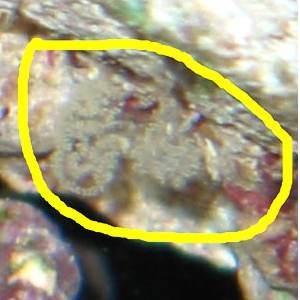
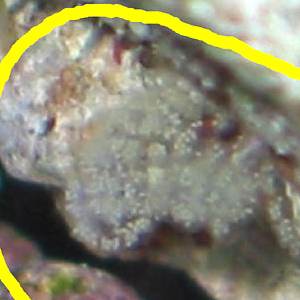
Dear Onel
Yes your animal is Tritoniopsis elegans and the other things do look a bit like its eggs. They are deposited in a jelly string like this with little white eggs. Marc Daniel' s recent message has a photo showing an egg mass. Although you can't see the spira arrangementof the whole egg ribbon you can see the typical zigzag folding of the ribbon.
Best wishes,
Bill Rudman
Tritoniopsis elegans in aquarium
January 22, 2003
From: Marc Daniels
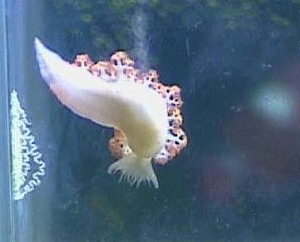
I discovered the Nudibranch in the attached images in my aquarium a few days ago. I've also come across posts in other board forums asking for this to be identifed, but they never have been.
Do you have any idea what it is, and also the dietary habits. It's beautiful in my tank, but I don't want it eating anything in my reef. If I knew what it ate, I would like to establish a species specific small aquarium to house it in.
Thanks for any help,
Marc Daniels
Sacramento, CA
USA
marc_daniels@dstoutput.com
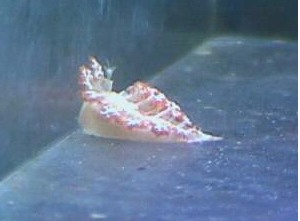
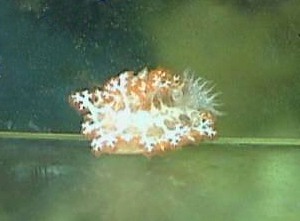
Dear Marc,
This is Tritoniopsis elegans. As you will see if you look at the other messages on this page, it is a specialised soft-coral feeder. If you are happy to keep buying soft-corals for it to eat you may be lucky and start a colony. Although, like all sea slugs, it is hermaphrodite, they don't self-fertilise, so you will need a second animal before breeding can commence, but again if your lucky, they tend to hitch rides on soft coral colonies so you might end up with another by accident. From other reports on the Forum which suggest this species does breed in aquaria, I assume that its larval life is very short, and probably non-feeding. If so, the likelihood of fertilised eggs resulting in young is quite high.
Best wishes,
Bill Rudman
Tritoniid in aquarium
January 18, 2003
From: Mary Middlebrook
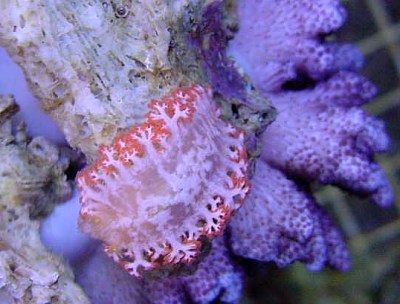
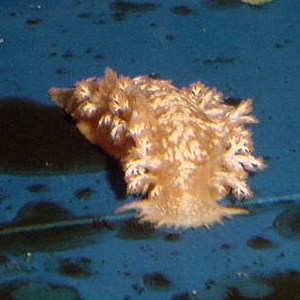
Dear Bill,
Following on from the Plakobranchus message, Here's another nudi I've found. Any idea what it is, goodness knows I know what it eats!! These nudibranchs are soft coral eaters! They have been coming in on Speckled Leathers and Colt Corals and have the ability to eat a large amount of tissue in a small amount of time. Possibly a Marionia sp., but if anyone has a positive ID for these monsters, please let me know.
One shown here underneath a Speckled Colony Leather, one of their favorite midnight snack.
Thank you,
Mary Middlebrook
http://www.reefsource.com/
marinewholesale@hotmail.com
Middlebrook, M., 2003 (Jan 18) Tritoniid in aquarium. [Message in] Sea Slug Forum. Australian Museum, Sydney. Available from http://www.seaslugforum.net/find/8960Dear Mary,
This is Tritoniopsis elegans. If you look at the other messages on this page you will see it appears to be commonly transported around on its favourite soft coral foods.
Best wishes,
Bill Rudman
Tritoniopsis elegans - causing aquarium problems
November 11, 2002
From: Sam Young
Thanks so much for helping identify the nudibranch that I observed in my tank as Tritoniopsis elegans. They certainly are beautiful animals. It was fascinating to see them lay eggs, have them hatch and then observe the babies crawling on the glass. The fascination ended when my largest soft coral started to decline and then completely disappeared. I have a 225 gallon tank. Several soft corals remain. 2 have been attacked and I hope they will survive. At this point I have removed about 20 elegans from the base of my soft corals. They multiply very fast. If there is a natural enemy to these nudibranch that is available for a reef tank I would be highly interested. In the meantime I plan on tearing the entire tank down to hopefully root out any remaining animals or egg strings.
Any ideas?
Sam Young
liberty-sam@msn.com
Young, S., 2002 (Nov 11) Tritoniopsis elegans - causing aquarium problems. [Message in] Sea Slug Forum. Australian Museum, Sydney. Available from http://www.seaslugforum.net/find/8399Dear Sam,
Sorry to hear of your disaster but it does raise an interesting point. From your observations it seems that this nudibranch has an abbreviated larval stage, which as far as I know has not been reported for this species before. 'Usually' a small free-swimming veliger larva hatches from each egg, and the larva spends days or sometimes weeks in the plankton, feeding on microscopic plants before settling down on to the bottom and transforming into a microscopic carnivorous slug. The plankton-feeding larval stage makes nudibranch particularly difficult to breed in aquaria. Some species however, have an abbreviated larval stage. In some cases, the veliger larvae does not feed and only lasts a few hours or days in the plankton before settling. In other cases a small crawling slugs hatches directly from the egg.
From your observations T. elegans has one of these abbreviated forms of larval development. Not good news for your aquarium I'm afraid, but certainly quite an interesting bit of information for those of us interested in nudibranchs. I don't suppose you have any photos of the eggs or the babies on your aquarium glass?
Concerning how to get rid of them from your aquarium. I'm sorry but I don't what you are doing is probably the only way. If any one else with an aquarium has had a similar experience I would like to know. Certainly if we can confirm that Tritoniopsis elegans does breed easily in aquaria, it is a nudibranch that should be treated with some caution by aquarium keepers
Best wishes,
Bill Rudman
Unexpected Tritoniopsis elegans guests
May 31, 2002
From: Mark Armstrong
Following a recent purchase of two leathery corals (one finger coral the other a toadstool) I found two animals who appear to be Tritoniopsis elegans! I only see them at night is this breed of nudibranch nocturnal? How much of a risk to my coral colonies do these two very interesting animals present? Are there any specific requirements (feeding, lighting or current) that I will need to modify? I have no idea where the corals originated only that they were supplied by TMC (one of the UK's largest livestock suppliers)
Mark Armstrong
mark.armstrong3@ntlworld.com
Armstrong, M., 2002 (May 31) Unexpected Tritoniopsis elegans guests. [Message in] Sea Slug Forum. Australian Museum, Sydney. Available from http://www.seaslugforum.net/find/7084Dear Mark,
I guess the nudibranchs hitched a ride as juveniles on the leathery soft-corals you recently acquired. If you look at the other messages on this page you will see that the leathery soft-corals is what they eat. So I guess they have some food but you may have to replace your soft-coral every now and then. Many nudibranchs are nocturnal and it is quite possible that this species is as well.
If you are happy to sacrifice the odd soft-coral or two, I don't think you will need to make any changes to your aquarium set up. It is probable that this species will only eat one species of soft-coral, so it is unlikely that other corals, anemones etc are at risk.
Best wishes,
Bill Rudman
Tritoniopsilla alba ? from the Philippines
April 24, 2002
From: Erwin Köhler
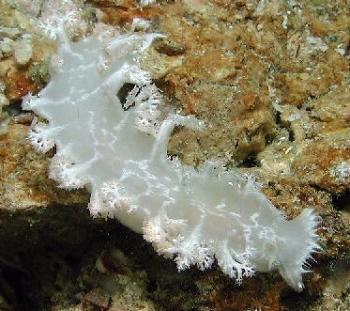
Dear Bill,
Is this Tritoniopsilla alba Baba, 1949? It is from the Philippines, Malapascua Island;
Divesite "Lapus Lapus".
Size: 72mm
Depth: 14m
Date: 26.Feb.2002
Erwin
Erwin@medslugs.de
Köhler, E., 2002 (Apr 24) Tritoniopsilla alba ? from the Philippines. [Message in] Sea Slug Forum. Australian Museum, Sydney. Available from http://www.seaslugforum.net/find/6746Dear Erwin,
The answer is yes and no. It is indeed Baba's Tritoniopsilla alba but that is now considered a colour form of Tritoniopsis elegans.
Cheers,
Bill Rudman
Tritoniopsis elegans and camouflage
October 18, 2001
From: Nishina Masayoshi
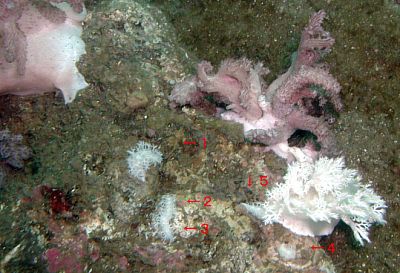
Dear Dr.Rudman,
I have observed the ecology of the various sea slugs in the sea before but I was really surprised at this observation. I could find what I thought at first was one sea slug [Tritoniopsis elegans when I turned over a stone (LOWER RIGHT). But, my wife noticed that gills apparently grew from that animal's foot as well (LOWER LEFT).
So I tried to remove the big sea slug from the stone because it seemed very strange for it to have gills on its foot. Then, five little sea slugs moved out from under that animal. Five little sea slugs were hiding under the foot or beside the foot of the big sea slug. It was an unbelievable sight (UPPER RIGHT PHOTO).
I sometimes see groups of the same sea slugs together but they are usually of the same size. Meanwhile, the big sea slug began to move to the end of the stone, and when it stopped one of the small ones followed it like a child following its parents. I realise that these animals don't provide 'childcare' and probably the large one isn't a parent of the small ones but it certainly gave that impression. Then, What does this mean? Are they only just hiding or are they clustered together for camouflage in a place where they look like the soft corals? I see that Bernard Picton has already sent a similar photo of T. elegans to Forum before. I wonder if the juveniles in his photo were hidden under the adult? or whether they were just close together?
Data:
Date:14 Oct, 2001
Location: Fukuura Port, Sagami Bay Japan
Length: Biggest one 50mm-60mm
Small sea slugs 10mm to 20mm
Best Regards,
Nishina Masayoshi
nishina@wips.co.jp
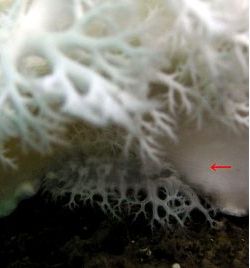
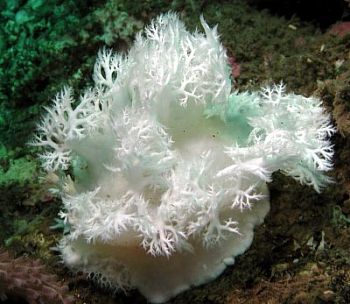
Dear Nishina,
What an interesting observation. I think the basic reason they are all together is that their food is nearby. I guess they were eating the colony which we can see broken off in your upper photo. Many sea slugs which eat massive colonies of soft corals and hard corals, cluster around the base of the colony, especially when they are juveniles, and in the case of hard corals like
I suspect that when large animals and small ones are together, the larger ones can crawl over the small ones like in your example. When they are very small their natural defence seems to be to hide, but as they grow larger and begin to look much like their food, they spend less time 'hiding' in crevices and under things, and begin to sit out in the open on their food, apparently relying on their camouflage to protect them.
Best wishes,
Bill.
White nudibranch from Dendronephthya
September 26, 2001
From: Wyatt Patry
I've found a completely white nudibranch in my 10 gallon reef tank in my dorm room. Believe this or not, Im amazed myself. It was crawling on a small sprout of Dendronephthya sp. I can't tell yet if it ate the polyps or not, or damaged it at all. I read the previous message and article on the two species that feed on the Dendro. but this is not either of them. This white one has frills around its "mantle" "epipodium", (I dont know the nudibranch anatomy well enough) the frills LOOK like the polyps of the Denro. so I was wondering if this might be a commensal species? These frills are all around the nudibranch. Oh and it is appearing at night, no lighting. This species seems to be from the genus Dendronotus, are there tropical species from this genus? Looks almost exactly like D. cf. dalli, but that's a colder water species. I have taken pictures with a disposable camera (prob wont turn out good at all), don't have acces to a digital. Sorry, any help in ID'ing this guy would be appreciated. Need to know if it's a threat to my corals, as I have two Dendronephthya sp. corals and Scleronephthya sp. corals, would like to keep them healthy.
Wyatt
UC Santa Cruz, California
wyattp@cats.ucsc.edu
Patry, W., 2001 (Sep 26) White nudibranch from Dendronephthya. [Message in] Sea Slug Forum. Australian Museum, Sydney. Available from http://www.seaslugforum.net/find/5320Dear Wyatt,
As a first guess have a look at the page and messages on Tritoniopsis elegans. It seems to be one of the most common 'hitch hikers' turning up in aquaria worldwide. It is white and eats soft corals. Let me know if this solves your problem.
Cheers,
Bill Rudman
Another aquarium mystery
September 16, 2001
From: Christy Falkenberg
Hi!
I just discovered that what I previously thought was new coral growth in my tank is what I think is a nudibranch. Previously it hung out next to my colt coral which kinda looked the same. Anyway, today I noticed that it has decided to hang out on the front glass of my tank so I can get a closer look. I will describe what it is that I have and hopefully someone out there knows what I am talking about.
Its about 2.5 inches long, fully extended (it shortened up later and is only about an inch long). It is all white and has little curlicues all over its back in two distinct rows on either side of its midline ("spine"). It also has a "mouthpart" that seems to stem from a single point and is shaped like an inverted triangle with little bristly things on the ends (which told me that it wasn't a coral, plus the fact that it is chugging along the glass
Anyone know what this is?? Good or bad??
Thanks in advance, sorry no pics
Christy
christyf5@excite.com
Falkenberg, C., 2001 (Sep 16) Another aquarium mystery. [Message in] Sea Slug Forum. Australian Museum, Sydney. Available from http://www.seaslugforum.net/find/5270Dear Christy,
I see 'Colt Coral' is a name used by the aquarium trade for finger-like soft corals. From that and your description I think you have an animal called Tritoniopis elegans which seems to be quite adept at staying alive on soft-corals as they are moved around the world. Have a look at the information at the top of the page, above your message, and also look at the other messages about this species which are attached to this page, below your message.
Basically, this animal eats this soft coral. It is quite beautiful, so if you are happy with the idea of replacing your soft coral every now and then, or growing replacements in a separate aquaria, my advice would be to keep it.
Best wishes,
Bill Rudman
Best wishes,
Bill Rudman.
Tritoniopsis elegans - eggs
August 19, 2001
From: Bernard Picton
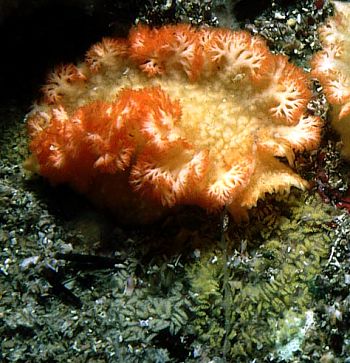
Hi Bill,
Here is another photo of Tritoniopsis elegans which is part of the series I sent earlier to show feeding behaviour. Like those this was taken in Hong Kong in April 1983.
We found this species in numbers at the most exposed rocks we visited at the entrance to Mirs Bay (Gau Tau). They were clustered round the edge of the soft coral colony, juveniles and adults all snuggled up together, and scattered on the rock alongside were many egg masses, some coloured yellow, some white.
Bernard
bernard.picton.um@nics.gov.uk
Picton, B.E., 2001 (Aug 19) Tritoniopsis elegans - eggs. [Message in] Sea Slug Forum. Australian Museum, Sydney. Available from http://www.seaslugforum.net/find/5078Thanks Bernard,
Bill Rudman
Tritoniopsis elegans feeding
August 18, 2001
From: Leslie Chan
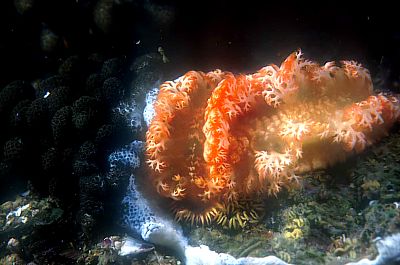
Dear Dr.Rudman
Thank you very much for your help on ID the nudibranchs of Hong Kong. Here is a photo of Tritoniopsis elegans feeding on soft corals for your reference.
Steep Island., Hong Kong, 9m 25 Feb; 2001
Thank you very much
Best regards
Leslie Chan
leslie@lesmart.com
Chan, L., 2001 (Aug 18) Tritoniopsis elegans feeding. [Message in] Sea Slug Forum. Australian Museum, Sydney. Available from http://www.seaslugforum.net/find/5072Thanks Leslie,
Bill Rudman
Tritoniopsis elegans from Hong Kong
August 18, 2001
From: Bernard Picton
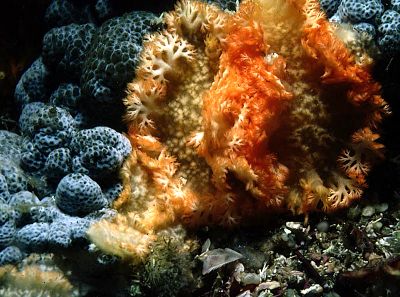
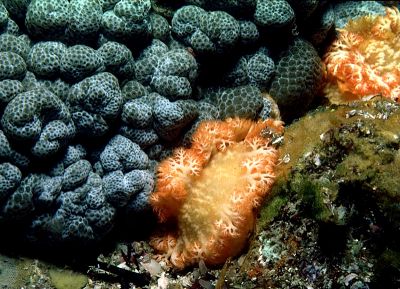
Hi Bill,
I took these pictures of Tritoniopsis elegans in Hong Kong during the April 1983 Workshop.
We found this species in numbers at the most exposed rocks we visited at the entrance to Mirs Bay (Gau Tau). They were clustered round an Alcyonacean type soft coral as shown here, juveniles and adults all snuggled up together round the base of the coral.
Bernard
bernard.picton.um@nics.gov.uk
Picton, B.E., 2001 (Aug 18) Tritoniopsis elegans from Hong Kong. [Message in] Sea Slug Forum. Australian Museum, Sydney. Available from http://www.seaslugforum.net/find/5075Thanks Bernard,
I think the soft coral is Lobophyton. As I have said with other Hong Kong records you have sent recently - I will add records of this species in Brian Darvell's Hong Kong collections as soon as I get them organised.
Best wishes,
Bill Rudman
Tritoniopsis elegans - hitchhiker
July 31, 2001
From: Tom O'Toole
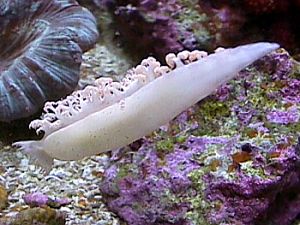
Hello-
I'm not sure if this has been discussed before but we have been seeing this critter popping up from time to time with shipments out of the indo-pacific.
I believe it is possibly Tritoniopsis elegans but I'm not sure. It is definitely a Tritoniid.
Tom O'Toole
Inland Reef Aquaria
Nashua, NH 03060, USA
tom@inlandreef.com
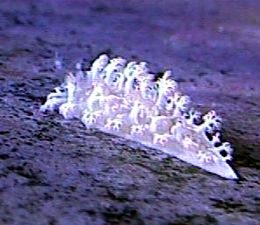
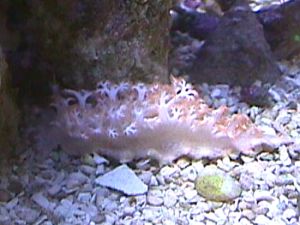
Dear Tom,
Thanks for the photos. If you have a look at the other messages on this page (just scroll up and down) you will see that this species is quite a common hitchhiker. It feeds on large massive softcorals such as Lobophyton so I guess it is being picked up as a juvenile on colonies of the soft corals and also on 'live rock' which has small attached softcoral colonies. Hopefully your customers will find the nudibranch more beautiful than the softcoral, as it gradually eats it.
The Forum is more than just a 'chatroom' so if you are looking for information just use the SEARCH button at the top and bottom of each page.
Best wishes,
Bill Rudman.
Tritoniopsis elegans from Hong Kong
July 8, 2001
From: Leslie Chan
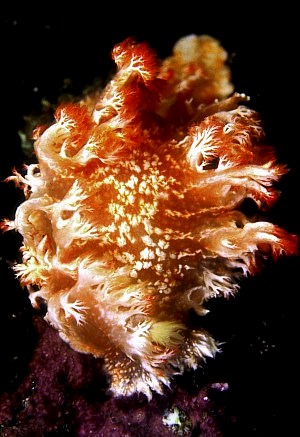
Dear Bill,
Could you identify this nudibranch which I photographed in Hong Kong.
Details: 7m, Long Ke, Hong Kong. 20 October 2000.
Thanks
Leslie Chan
leslie@lesmart.com
Chan, L., 2001 (Jul 8) Tritoniopsis elegans from Hong Kong. [Message in] Sea Slug Forum. Australian Museum, Sydney. Available from http://www.seaslugforum.net/find/4763Dear Leslie,
This is Tritoniopsis elegans. It ranges in colour from white to orange and red, probbaly related to the colour of the soft-corals on which it feeds.
Best wishes,
Bill Rudman
Tritoniopsis elegans in aquarium
May 11, 2001
From: Donna Pinnock
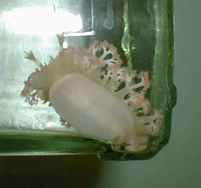
I have purchased some live rock this afternoon with a soft coral and have discovered this slug in the tank. I have removed it for the time being as I do not know if it is harmful to the invertebrates or corals in the reef tank. A Picture of the slug is attached, bot its general best description is 'like cauliflower'.
Donna Pinnock
pinnock@ntlworld.com
Pinnock, D., 2001 (May 11) Tritoniopsis elegans in aquarium. [Message in] Sea Slug Forum. Australian Museum, Sydney. Available from http://www.seaslugforum.net/find/4310Dear Donna,
Your slug is Tritoniopsis elegans and is found throughout the tropical Indo-West Pacific. It does feed on soft corals so I guess it has been living on the one you bought. I don't know how long soft corals live in home aquaria, but if it is not long I would recommend you keep the slug - but I am biased.
Best wishes,
Bill Rudman
Tritoniopsis elegans in aquarium
February 9, 2001
From: Tracey Bollier
We have discovered about 10 Tritoniopsis elegans adults (approx 55 mm long) and quite a few patches of eggs (layed in circles) in our reef tank. They were devouring one of our leather finger corals. We have removed them from the tank, but don't know what to do with them now. Does anybody collect these? Is there any other food they will live on other than soft corals?
Tracey Bollier
tracey.bollier@ch.abb.com
Bollier, T., 2001 (Feb 9) Tritoniopsis elegans in aquarium. [Message in] Sea Slug Forum. Australian Museum, Sydney. Available from http://www.seaslugforum.net/find/3749Dear Tracey,
I am afraid your 'Leather Finger Coral' is what Tritoniopsis elegans eats, and is probably how they came to be in your aquarium - on the soft coral when they were minute juveniles.
About what you should do with them. It really depends how easy it is to replace the Soft Coral. I am biased, but if the Soft Coral was not that difficult to replace, I would suggest keeping a couple of the nudibranchs in your aquarium. I suspect they have planktonic larvae, which would be most unlikely to survive in your tank, so I doubt if there egg-laying would mean that you will end up with unmanageable numbers.
Other than keeping one or two, your only other alternative is to kill them all. If you live near the sea, PLEASE DON'T release them into your local waters. It may seem a kind thing to do, but if they survive, they could cause a major environmental problem.
Best wishes,
Bill Rudman
Tritoniopsis elegans from South Africa
January 27, 2001
From: Valda Fraser
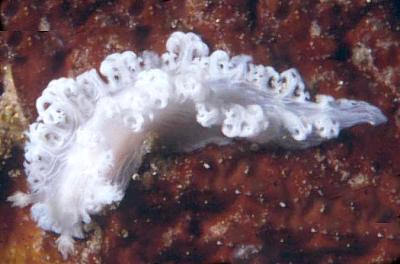
Dear Bill
A real beauty! Please tell me it's name.
Locality: Sodwana, north coast KwaZulu-Natal, SOUTH AFRICA - 18m
Date: Jan 2001
Size: 30mm
Thanks.
Regards
Valda Fraser
nunu28
valda fraser@mweb.co.za
Fraser, V., 2001 (Jan 27) Tritoniopsis elegans from South Africa. [Message in] Sea Slug Forum. Australian Museum, Sydney. Available from http://www.seaslugforum.net/find/3624Dear Valda,
This beauty is Tritoniopsis elegans. It ranges in colour from this pure white form to forms with red-orange gills.
Best wishes,
Bill Rudman.
Unknown Nudibranch
December 12, 2000
From: Marc Elig
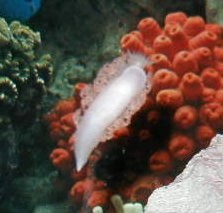
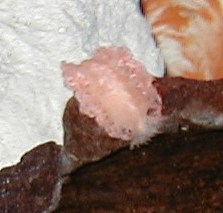
I recently added some live rock and discovered a Nudibranch in my sump today. From the descriptions given in "The Reef Aquarium" Vol 1, it appears to be suborder Aeolidacea. It is peach colored, has the rhinophores and oral tentacles that look like two hands laid flat palms down with thumbs and index fingers touching. It has cerata running down both sides of the body that are like hoops of yarn. Does anyone recognize this picture:
http://www.homestead.com/eligsreef/home.html
I'd like to know what it eats. I've got it in my quarantine tank, until I can verify if it's safe. I'd like to keep it alive if possible, but I understand that they are usually very specific eaters. I just started the webpage above to show this picture. Sorry the enlargement link didn't work. Soon I'll put my tank pictures on the web page. Thanks for any help.
Marc Elig
melig@goldnet.it
Elig, M., 2000 (Dec 12) Unknown Nudibranch. [Message in] Sea Slug Forum. Australian Museum, Sydney. Available from http://www.seaslugforum.net/find/3297Dear Marc,
Your animal is a tritoniid rather than an aeolid, and like most of its relatives it feeds on soft corals. If you look at the decription above your message and the information in the other messages below yours, you will find further information about feeding in this species, Tritoniopsis elegans.
Best wishes,
Bill Rudman
Tritoniopsis - another hitchhiker
September 23, 2000
From: Jim Roth
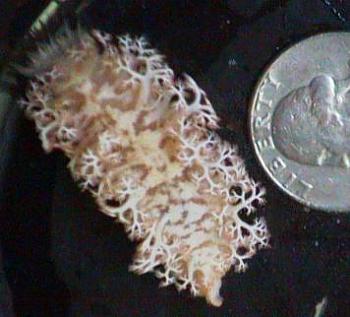
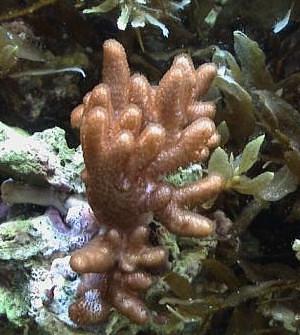
Hi,
I received a mystery nudibranch in some corals from Indonesia. Picture attached. It has been living on (and eating) a soft-coral I think is Cladiella. Initially I removed it, then I decided It was more interesting to have a beautiful nudibranch than another Cladiella. I put it back.
Somebody has tentatively ID'd it as Tritonopsis. I have a couple of questions:
1) Will it eat anything besides Cladiella? (Colt or Xenia?) I'd like to get another fast-growing soft coral to feed it.
2) I believe I have only one of these. Can it still reproduce in my 90g tank? I don't want an infestation.
Thanks for your help.
Jim Roth
roth@monmouth.com
Roth, J., 2000 (Sep 23) Tritoniopsis - another hitchhiker. [Message in] Sea Slug Forum. Australian Museum, Sydney. Available from http://www.seaslugforum.net/find/3057Dear Jim,
Yes your nudibranch is Tritoniopsis elegans. You'll see from the other messages below yours that this is not the first time it has been reported as a hitchhiker. Concerning whether it will eat other soft-corals. Our knowledge of what many tropical nudibranchs eat is still very rudimentary. Tritoniopsis is a soft-coral feeder and presumably it arrived and survived in your tank on a piece of soft-coral. However I can't say which ones it will eat and so can't recommend a fast growing one for you to buy.
Concerning it reproducing in your aquarium. If you have only one then the chances are zero. Although nudibranchs are hermaphrodites, with a full set of male and female organs, they do not self-fertilise. Since your animal was obviously very small when collected, it is unlikely to have mated before you got it. The apparent infestation reported in an earlier message is probably the result of a lot of microscopic juveniles being on a soft-coral when it was introduced into the aquarium.
Best wishes,
Bill Rudman.
Tritoniopsis elegans in aquarium
January 4, 2000
From: Cindy Nichols
Dear Bill,
I found 10 of these things in my 72 gallon tank. I kept losing fish and corals. I took my tank apart and they were everywhere, also their eggs. I never saw them until day before yesterday (01 01 2000). Can they hurt your fish?
Their sizes run from 3in to babies. I put them in my holding tank. Can you help? Please.
Cindy.
cindynichols@worldnet.att.ney
NIchols, C., 2000 (Jan 4) Tritoniopsis elegans in aquarium. [Message in] Sea Slug Forum. Australian Museum, Sydney. Available from http://www.seaslugforum.net/find/1727Dear Cindy,
Tritoniopsis elegans feeds on soft corals so they won't hurt your fish directly. It is possible that if there are enough of them in your aquarium they may kill a soft-coral colony. If parts of the colony were to rot rather than be eaten it is possible thye could foul the water.
Personally, I think they are so spectacular, you should give them a chance by only keeping a few, and watching for signs of soft coral colonies rotting..
Best wishes,
Bill Rudman.
Tritoniopsis from Thailand
July 9, 1999
From: Erwin Koehler
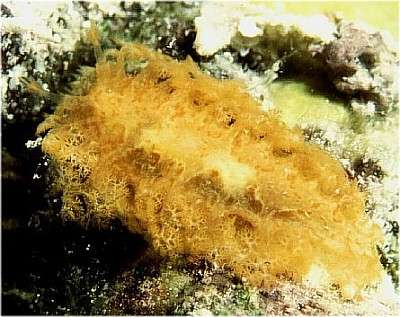
Bill,
Attached is 1 photo by Georg Heinze: Thailand, Similan Is., March 1999,
size unknown. Any idea?
Erwin
Medslugs.Koehler@t-online.de
Koehler, E., 1999 (Jul 9) Tritoniopsis from Thailand. [Message in] Sea Slug Forum. Australian Museum, Sydney. Available from http://www.seaslugforum.net/find/1032Dear Erwin,
This is Tritoniopsis elegans which apparently ranges in colour from white through yellow, orange and almost red. Sometimes in the the deeper orange-red colour forms the pigment is more concentrated in the gills which makes them quite spectacular to look at.
Bill Rudman.
Rudman, W.B., 1999 (Jul 9). Comment on Tritoniopsis from Thailand by Erwin Koehler. [Message in] Sea Slug Forum. Australian Museum, Sydney. Available from http://www.seaslugforum.net/find/1032Sponge-feeding tritoniid?
April 14, 1999
From: David & Leanne Atkinson


Hi Bill,
Here is another interesting thing we photographed while busy diving over Easter.
I think it is some kind of Tritonia and it seemed to be eating the orange sponge. At Halifax Park in 18m. [Port Stephens, New South Wales, Australia].
David & Leanne Atkinson
atkin@hunterlink.net.au
Atkinson, D. & L., 1999 (Apr 14) Sponge-feeding tritoniid?. [Message in] Sea Slug Forum. Australian Museum, Sydney. Available from http://www.seaslugforum.net/find/773Dear David & Leanne,
I think these are juveniles of Tritoniopsis elegans which like all tritoniids we have information on, feed on soft-corals. The pink stuff they are crawling on certainly looks like sponge. Perhaps they are feeding on some cnidarian which is living on the sponge. Or perhaps when they settled out of the plankton they chose a very small soft-coral colony which they have exhausted and are now looking for more.
Bill Rudman.
Nudibranch in reef tank
January 4, 1999
From: Eirik Mack Eilertsen

This might be a bit out of the ordinary, but I've tried posting my question through aquarium related channels with no luck.
While looking into my reef tank with a flashlight one night, I stumbled across a big (1"), white opistobranch that seemed to be busy laying eggs in chains consisting of sausage shaped egg containers. The animal itself seems almost transparent white with snow white branched, feathery gills arranged in two lateral lines.
Enclosed are some simple drawings of what the animal looked like, with an additional close up view of one of the animals two tentacles. They did seem rather special to me, and might help you to ID the animal. The gills are more branched/feathery than what thy look like in the picture and is the overall striking feature of the animal.
Anything you can tell me about these animals would be greately appreciated. Quite a few nudibranchs are known to do inflict damage to corals and polyps, and most aquarists (although none of them able to ID the animals) told me to get rid of them. Personally I like them, and if possible would very much like to keep them.
The animals must have been introduced with corals shipped from Indonesia. If anyone knows what it could be and how I can best care for it, I would be grateful.
Thanks in advance.
Eirik Mack Eilertsen
Norwegian College of Fisheries Science
University of Tromsoe,
Tromsoe,
Norway
eirike@stud.nfh.uit.no
Eilertsen. E.M., 1999 (Jan 4) Nudibranch in reef tank. [Message in] Sea Slug Forum. Australian Museum, Sydney. Available from http://www.seaslugforum.net/find/434Dear Eirik,
Your drawings show all the characteristic features of a family of nudibranchs called the Tritoniidae. The rhinophores (head tentacles) have a ring of papillae around a central core which is unique to them. I can't be 100% certain but I suspect your animal is Tritoniopsis elegans. Have a look at the photos I have posted at the top of this page. When large their gills becomes large and expansive and give the body a flattened lace-like appearance. However, up to about the size of your animal, they have a more erect shape as you have drawn.
Whether you have this species or not, they will not eat hard corals but do feed on soft-corals, and it seems that most species have a fairly specific diet. Tritoniopsis elegans usually feeds on Lobophyton but has been recorded on other soft-corals such as Spongodes. If you have soft-corals in your aquarium it may find one to its liking. I would think you would notice if it was causing damage as it will only eat a bit at a time. If you haven't soft-corals it won't eat your hard corals. If that is the case then unfortunately it will gradually die of starvation. My feeling would be to let it live out its last days in the relative sanctuary of your aquarium.
Best wishes,
Bill Rudman.
PS. Please let me know if I guessed right?
Re: Nudibranch in reef tank
January 4, 1999
From: Eirik Mack Eilertsen
Thank you very much for identifying my nudibranchs. You are definately right in your assumption as to their identity. I was a bit sad, however, to learn that the animals feed on at least one species of soft corals. They could very well be responsible for the sudden loss of vigour showed by almost all of my soft corals.
I've asked a British expert on marine aquaria about what he knows about this species and if it really has to go in order for me to run my tank. It does seem a shame to destroy such a beautiful animal...
Eirik Mack Eilertsen
Tromsoe
NORWAY
eirike@stud.nfh.uit.no
Eilertsen. E.M., 1999 (Jan 4) Re: Nudibranch in reef tank. [Message in] Sea Slug Forum. Australian Museum, Sydney. Available from http://www.seaslugforum.net/find/439Nice to start the New Year with a winner! Not all identifications are that easy.
Best wishes,
Bill Rudman.
